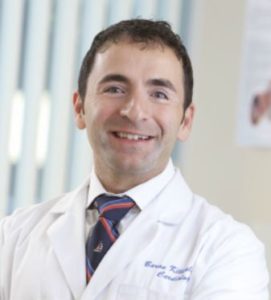WASHINGTON — Shortly after Christmas, while the hospital was bracing for the tidal wave that would be omicron, the DCVAMC made history, becoming the first VA in the nation to use new cardiac mapping technology to perform a cardiac ablation procedure. The technology is designed to give physicians a much more complex and complete map of the area of the heart that they are navigating, resulting in more precise, quicker procedures.
The Ensite X mapping platform designed by Abbott was purchased by the hospital to coincide with the arrival of Baran Kilical, MD, DCVAMC’s new cardiac electrophysiology expert, who specializes in the electrical conducting systems of the heart and how to correct any misfirings that arise.
“Your heart basically has a timing belt—that’s the electrical wiring that tells each chamber when to squeeze,” Kilical explained. “If you go for a jog, your heart speeds up. And when you have a discrepancy in these, you get quality-of-life issues like Afib and things like ventricular tachycardia, which can lead to sudden death. I figure out who’s at risk for these and treat them.”
One of the most common procedures to correct for atrial fibrillation is cardiac ablation, where a physician sends a catheter into the heart, locates where the electrical misfire is occurring and then uses heat or cold to create scar tissue to block the signals.
The challenge in a procedure like this is seeing where you’re going. In the past, Kilical would use intermittent X-rays to show where the catheter was in the heart, which were activated by a foot-controlled pedal. It gave him a stop-motion view of the area he was navigating.
The new Ensite X platform provides a full 3-D model of the heart, with sensors in the catheter showing its real-time location in the organ.
“With 3-D mapping, we’re minimizing X-ray use, plus we’re getting real-time visualization of all the catheters in the heart,” he explained.
Like previous technology, it also tracks the electrical signals of the heart. But it does so with more versatility. Where previous technology resulted in what Kilical called “squiggles” representing electrical current, the Ensite X allows the cardiologist to adjust how that information is interpreted on the screen.
“We’re still getting the squiggles, but with 3-D mapping it maps all that out for you and shows it how you want. It can be color coded or flowing [like a weather map].”
This advance in computer-aided interpretation takes a huge burden off of physicians, Kilical explained.
“This makes a big jump in the way that the computer interprets this information and presents it,” he said. “The human brain cannot hold that kind of information just looking at squiggles. [Now] we can take on much more complex arrhythmia.”
The system also provides Kilical with input on how much pressure he’s exerting with the catheter. In the past, he was required to do it through touch–using just enough force to complete the procedure but not so much that the patient is ever in danger.
“With this system, catheters are actually force-sensing,” he said. “At all times, I can see how many grams of force I’m exerting at the tip of the catheter.”
The end result of all of this new technology, Kilical explained, is better, safer procedures for veterans.
“We can see, and we can maneuver the catheters; there’s less X-ray; there’s more precision; and less time on the table means better outcomes.”
Kilical said he also hopes that the technology will allow DCVAMC to take on more difficult cases and a wider array of procedures.
“The more complex stuff, we wouldn’t attempt without having this,” he said. “The tool helps us take on cases that we would otherwise try to treat with medication. We can take on much more complex arrhythmias.”
The next phase for DCVAMC’s cardiology lab is to delve into the world of clinical research. Kilical shared that he is particularly excited about the potential for new energy sources that might be used in ablations.
“There’s a new energy form on the horizon—electroporation, where we use current, not heat or cold, to actually change the electrical conduction rapidly across heart muscle cells,” Kilical explained. “Thereby scarring only heart muscle cells without collateral damage to other structures.”
“That’s my vision for the future of the lab,” he added. “[Giving patients access] to procedures that are only available to those who are pushing the envelope.”

